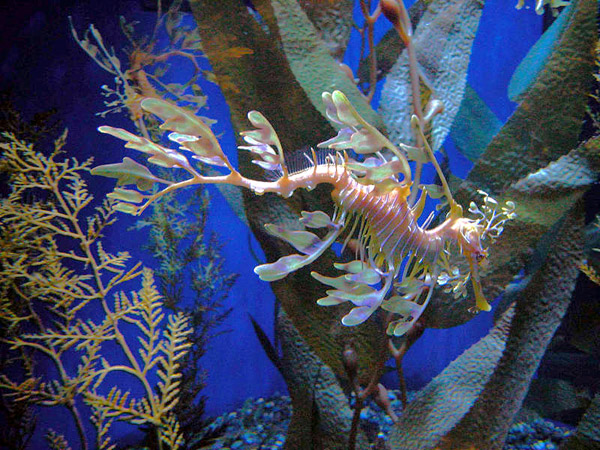Leafy Seadragon
Phycodurus eques
Named seadragons after the dragons of Chinese legends, leafy seadragons definitely resemble the dragon of fairy tales. They are bony fish in the family Syngnathidae which includes seahorses and pipefishes. Although relatives, their appearance is quite different in that they have a tail that cannot be coiled and they have leaf-like appendages on the head and body.

Credit: Aquarium of the Pacific, B. Gray

Photo taken at the Aquarium of the Pacific's seadragon habitat Credit: Aquarium of the Pacific and K. Leonard
SPECIES IN DETAIL
Leafy Seadragon
Phycodurus eques
CONSERVATION STATUS: Least concern
CLIMATE CHANGE: Uncertain
At the Aquarium
Leafy seadragons are not on exhibit at the Aquarium.
Geographic Distribution
Coastal waters off the states of Western Australia, South Australia, and Victoria in southern Australia.
Habitat
These seadragons inhabit temperate coastal waters of southern Australia where water temperatures are seasonally between 13 to 19o C (55 to 67o F). They live among rocky reefs, sand patches close to the reefs, seaweed beds, and seagrass meadows. Populations may fluctuate seasonally in response to food availability and spawning season. Leafy seadragons can be found from the surface to depths of 98 feet (30 meters).
Physical Characteristics
Members of the Sygnathidae family have fused jaws and rigid bodies. The scaleless body of seadragons is covered is covered in hard bony plates. They have a small head with a long, thin pipe-like snout and a tail that is about half their total length. Elaborate leaf-like appendages protrude from the head, body, and tail. They have transparent dorsal and pectoral fins that are small and have a very fine appearance but they have lost their caudal and pelvic fins. They have long sharp spines on each bony plate that may be used defensively.
Shallow water leafy seadragons are yellow-brown or greenish with dark pink rib bands and green-brown pronounced leafy appendages. Those that live in deeper water are dark brown to burgundy red.
Size
The maximum length of the leafy seadragon is about 35 cm (14 in).
Diet
Sea dragons do not have teeth or a stomach; therefore they eat almost constantly while covering wide areas searching for prey. They feed on mysid shrimp, a favorite food, and other small crustaceans, plankton, and larval fishes. They swallow their prey whole, creating suction to suck the food item into their small mouth by expanding a joint on the lower part of their snout. This feeding technique is similar to how a pipette works.
Reproduction
Like their seahorse relatives, male seadragons brood the eggs, which are incubated on a brood pouch on the underside of the tail. The female lays 250 to 300 eggs that are 4 mm (0.16 in) in diameter and 7 mm (0.3 in) long. She pushes them into the skin of the male to be fertilized, covering most of the under surface and sides of his tail immediately behind his anus. His skin, soft at the time the eggs are first embedded, becomes hardened to form a cup around each egg to hold it securely for the six- to eight-week incubation. When hatching starts, the male releases only a few eggs at a time. He may take from hours to days to let go of the entire brood.
Fry unroll from their tight position in the egg capsule, coming out tail first. They have a very short snout, lack leafy appendages, and are colored silver and black. They settle out on the substrate in shallow water where they live off the still-attached egg capsule for about two days until their snout is more pronounced and they are ready to start hunting.
Behavior
Usually solitary, these fish move to deeper water during the Australian winter when food is scarce. In late winter they migrate to selected shallow bays, forming congregations to pair and eventually mate.
The outer skin of these fish is solid, limiting mobility. They swim through the water by rapidly oscillating their small, almost translucent fins and using their tails as rudders. The amount of air in their swim bladders fluctuates so that they can hold their position vertically or move themselves up and down in the water column.
Adaptation
Slow-swimming and with fragile bodies, seadragons depend on camouflage to hide them from predators. Their leafy appendages, ability to change color to match their seaweed and seagrass habitats, and ability to sway like plants in the water current help protect them from predators.
Longevity
Leafy seadragons’ longevity in their natural environment is unknown, but it is estimated that they may live seven to ten years.
Conservation
Leafy seadragons were listed as near threatened on the IUCN Red List until 2006. These fish are in trouble because of habitat destruction due to human development, pollution, excessive fertilizer runoff, and fishing practices where they may be trapped as bycatch or poached. Additionally, their populations may be threatened by rough seas and limited food supply.
To help conserve syngnathid populations in their natural environment, construction and development in coastal areas should be limited; fisheries should be well regulated, especially in shallow water habitats where seadragons live; and pollutants should be prevented from entering the ocean through run-off. Preserving and protecting the ecosystems that are home to the beautiful and intriguing syngnathid family of marine animals will improve their populations.
Because they are inhabitants of temperate waters, seadragons may be impacted by an increase of water temperature as a result of global climate change.
Special Notes
The leafy sea dragon is the official marine emblem of the state of South Australia.
SPECIES IN DETAIL | Print full entry
Leafy Seadragon
Phycodurus eques
CONSERVATION STATUS: Least concern
CLIMATE CHANGE: Uncertain
Leafy seadragons are not on exhibit at the Aquarium.
Coastal waters off the states of Western Australia, South Australia, and Victoria in southern Australia.
These seadragons inhabit temperate coastal waters of southern Australia where water temperatures are seasonally between 13 to 19o C (55 to 67o F). They live among rocky reefs, sand patches close to the reefs, seaweed beds, and seagrass meadows. Populations may fluctuate seasonally in response to food availability and spawning season. Leafy seadragons can be found from the surface to depths of 98 feet (30 meters).
Members of the Sygnathidae family have fused jaws and rigid bodies. The scaleless body of seadragons is covered is covered in hard bony plates. They have a small head with a long, thin pipe-like snout and a tail that is about half their total length. Elaborate leaf-like appendages protrude from the head, body, and tail. They have transparent dorsal and pectoral fins that are small and have a very fine appearance but they have lost their caudal and pelvic fins. They have long sharp spines on each bony plate that may be used defensively.
Shallow water leafy seadragons are yellow-brown or greenish with dark pink rib bands and green-brown pronounced leafy appendages. Those that live in deeper water are dark brown to burgundy red.
The maximum length of the leafy seadragon is about 35 cm (14 in).
Sea dragons do not have teeth or a stomach; therefore they eat almost constantly while covering wide areas searching for prey. They feed on mysid shrimp, a favorite food, and other small crustaceans, plankton, and larval fishes. They swallow their prey whole, creating suction to suck the food item into their small mouth by expanding a joint on the lower part of their snout. This feeding technique is similar to how a pipette works.
Like their seahorse relatives, male seadragons brood the eggs, which are incubated on a brood pouch on the underside of the tail. The female lays 250 to 300 eggs that are 4 mm (0.16 in) in diameter and 7 mm (0.3 in) long. She pushes them into the skin of the male to be fertilized, covering most of the under surface and sides of his tail immediately behind his anus. His skin, soft at the time the eggs are first embedded, becomes hardened to form a cup around each egg to hold it securely for the six- to eight-week incubation. When hatching starts, the male releases only a few eggs at a time. He may take from hours to days to let go of the entire brood.
Fry unroll from their tight position in the egg capsule, coming out tail first. They have a very short snout, lack leafy appendages, and are colored silver and black. They settle out on the substrate in shallow water where they live off the still-attached egg capsule for about two days until their snout is more pronounced and they are ready to start hunting.
Usually solitary, these fish move to deeper water during the Australian winter when food is scarce. In late winter they migrate to selected shallow bays, forming congregations to pair and eventually mate.
The outer skin of these fish is solid, limiting mobility. They swim through the water by rapidly oscillating their small, almost translucent fins and using their tails as rudders. The amount of air in their swim bladders fluctuates so that they can hold their position vertically or move themselves up and down in the water column.
Slow-swimming and with fragile bodies, seadragons depend on camouflage to hide them from predators. Their leafy appendages, ability to change color to match their seaweed and seagrass habitats, and ability to sway like plants in the water current help protect them from predators.
Leafy seadragons’ longevity in their natural environment is unknown, but it is estimated that they may live seven to ten years.
Leafy seadragons were listed as near threatened on the IUCN Red List until 2006. These fish are in trouble because of habitat destruction due to human development, pollution, excessive fertilizer runoff, and fishing practices where they may be trapped as bycatch or poached. Additionally, their populations may be threatened by rough seas and limited food supply.
To help conserve syngnathid populations in their natural environment, construction and development in coastal areas should be limited; fisheries should be well regulated, especially in shallow water habitats where seadragons live; and pollutants should be prevented from entering the ocean through run-off. Preserving and protecting the ecosystems that are home to the beautiful and intriguing syngnathid family of marine animals will improve their populations.
Because they are inhabitants of temperate waters, seadragons may be impacted by an increase of water temperature as a result of global climate change.
The leafy sea dragon is the official marine emblem of the state of South Australia.

